Articles & Whitepapers
Global Mobility Strategies for Enhancing Employee Well-Being
Global mobility, the practice of relocating employees across borders for work assignments, has become essential in today's competitive and interconnected business landscape. As corporations expand operations globally, the demand for a diversified workforce capable of navigating different cultural contexts rises. However, global mobility carries its own unique set of challenges, a significant one being the necessity to ensure employees have a positive experience during their global transfers. This article highlights the significance of enhancing the employee experience in global mobility and proposes effective strategies for successful implementation.
Conclusion
Employee experience is vital for successful global mobility and business operations on a global scale. Prioritizing employee wellbeing, development, satisfaction, and recognition ensures rewarding global experiences for both employees and organizations. By adopting inclusive policies, promoting effective communication, and putting appropriate planning into practice, businesses can successfully address the challenges that come with global mobility.
NEI Global Relocation is honored to feature this insightful article, expertly authored by Klippa Relocation. As part of our commitment to supporting employees and their families during their relocation journeys, we're delighted to showcase Klippa's exemplary services. Klippa excels as a leading provider of relocation, immigration, and corporate services, facilitating smooth transitions across the globe. Their dedication to seamless relocation experiences is evident in thand in every service they offer.
Shipping Disruptions Impact Relocation
International shipping faces several disruptions heading into 2024, making it hard to forecast how things will play out.
Situation:
While freight rates are lower when compared to the recent past, concerns over rising costs and delays in import shipments are again increasing due to these developing situations:
Middle East – Red Sea
Attacks on cargo ships in the Bab-el-Mandeb Strait of the Red Sea – where about 12 percent of global shipping sails through – have prompted hundreds of cargo ships carrying over 2 million containers to reroute from the Red Sea. Rerouting will result in longer transit times and elevated costs.
Changing a cargo ship’s route from Asia to Europe around the southern tip of Africa, rather than using the Suez Canal in the Red Sea, represents a major detour. For example, a cargo ship’s voyage from Singapore to Rotterdam would be extended by 3,300 miles, a 40 percent increase, adding approximately 10-to-14 extra days in transit and sizeable costs.

With the international community mobilizing to stop this disruption to global trade, it is possible that these ship diversions could end soon, but only time will tell.
Central America – Panama Canal
Simultaneously, the 50-mile-long Panama Canal – which 5-to-6 percent of global shipping flows through – has had a 33 percent capacity reduction due to a drought, posing challenges in the shipping bottleneck area. Ships moving through the canal have faced wait times of up to three weeks. Delays are expected to continue until April / May 2024, when the rainy season is expected to raise the low water levels and end the region’s drought.
North America – US Mexico Border and West Coast Ports
Congestion of freight traffic at the Mexico-U.S. border is escalating and likely to continue its upward trend. This increase stems from the U.S. actively suspending freight train services across the border to counter unauthorized migrant crossings. The resulting shift from rail to truck transport for containers could significantly impact freight capacity, costs, and transit durations.
Both shippers and the broader supply chain should remain attentive to the potential recurrence of increased activity and congestion at major U.S. west coast ports next year due to an anticipated surge in cargo from Asia to U.S. East Coast. This surge could strain trucking services and create logistical delays similar to those experienced during the pandemic.
What You Can Do
Companies should look for rate increases and a potential rise in incremental costs due to delayed shipments (e.g., temporary housing), as well as increased stress from relocating employees who will have to wait longer than expected for their goods.
If NEI is not managing your international shipments, we recommend:
- Budgeting for additional freight rates in your cost estimates
- Working with partners to develop processes that include verification that freight increases are genuine
- Questioning rates that are much lower when compared to the overall market; which is often an attempt to lock in business with large increases coming without warning
NEI Guidance
Be prepared for these shipping trends to continue. Consider reasonable policy changes going forward, like the following:
- Allowing exceptions specifically due to continued and new shipping disruptions in 2024
- Setting new expectations with relocating employees
- Considering alternative policy options for shipping international household goods
NEI remains committed to managing client costs for every move. Our Client Relations Managers will collaborate with each client to identify the most cost-effective options for international household goods shipping. They will also discuss providing a small allowance to employees for the extended transit period without their goods.
In Summary
NEI and our service partners will keep you posted on this developing situation, but if you would like to discuss policy changes or options to reduce global container shipment costs, please reach out to your NEI representative or Mollie Ivancic, NEI’s VP, International Services.
This material has been prepared for informational purposes only and is not intended to provide, and should not be relied on for tax, legal or accounting advice. Please consult your own tax, legal and accounting advisors before engaging in any transaction.
NEI’s Brian Digan Receives the NTRP 2023 Saul Gresky Relocation Professional of the Year Award
NEI Global Relocation is delighted to announce that our own Brian Digan, Vice President of Client Development, is the 2023 recipient of the North Texas Relocation Professional (NTRP) Saul Gresky Award.
This honor is bestowed upon an exceptional corporate or relocation service professional who embodies the essence of outstanding customer satisfaction, going above and beyond to serve corporate employees in their relocation journeys.
Located in Dallas, Brian boasts 40 years in the industry, fostering relationships with diverse corporations across multiple cities. Through his unwavering commitment to the industry, Brian has contributed significantly to enhancing the positive image of the relocation profession, fostering collaboration and support across numerous groups.
A proud Villanova University alumnus, Brian earned his MBA from the University of Connecticut School of Business and, as NTRP Treasurer, Brian has helped the group provide a forum for education and networking in all areas of relocation by both corporations and service sectors of the industry.
In an industry where service, ethics, and professionalism are key, NEI Global Relocation celebrates Brian for his industry efforts, achievements, and winning this year’s Saul Gresky Award.
Congratulations, Brian, for your dedicated and positive impact on improving corporate relocation experiences for employees and companies. Your efforts are truly appreciated.
Navigating New Mileage Rates, Tax Bracket Changes, and More for Relocation
With the new year comes new caps, tax tables and allowances from the U.S. Internal Revenue Service (IRS). Listed below are the areas related to relocation for tax year 2024.
Standard Mileage Rate
The IRS announced an increase of the optional standard mileage rates for 2024. The standard mileage rates for the use of a car (also vans, pickups or panel trucks) will be:
- 67 cents per mile driven for business use, an increase of 1.5 cents from 2023.
- 21 cents per mile driven for medical or moving purposes for qualified active-duty members of the Armed Forces, a decrease of 1 cent from 2023.
- 14 cents per mile driven in service of charitable organizations; the rate is set by statute and remains unchanged from 2023.
Most companies follow the IRS guidelines to calculate the mileage reimbursements for final move expenses when driving to the new location. This rate increase will affect mobility programs:
- If you are an NEI client who has elected to follow IRS guidelines for your expense administration, nothing is needed at this time. NEI will incorporate the mileage change into your expense reimbursement policy, as agreed.
- If you are an NEI client who has not elected to follow the government established mileage rates in the past, NEI will continue to follow your prescribed rates unless you advise us that your company is changing the rate. Please contact your NEI Client Relations Manager directly, if you would like to confirm or update your current rate.
IRS Federal Income Tax Brackets and Rates
The IRS has also announced new 2024 tax year tax brackets, for taxes one will file in April 2025.
- The IRS has adjusted the brackets for 2024 based on inflation, which is considered annually.
- One’s tax bracket depends on one’s taxable income and filing status: single, married filing jointly or qualifying widow(er), married filing separately and head of household.
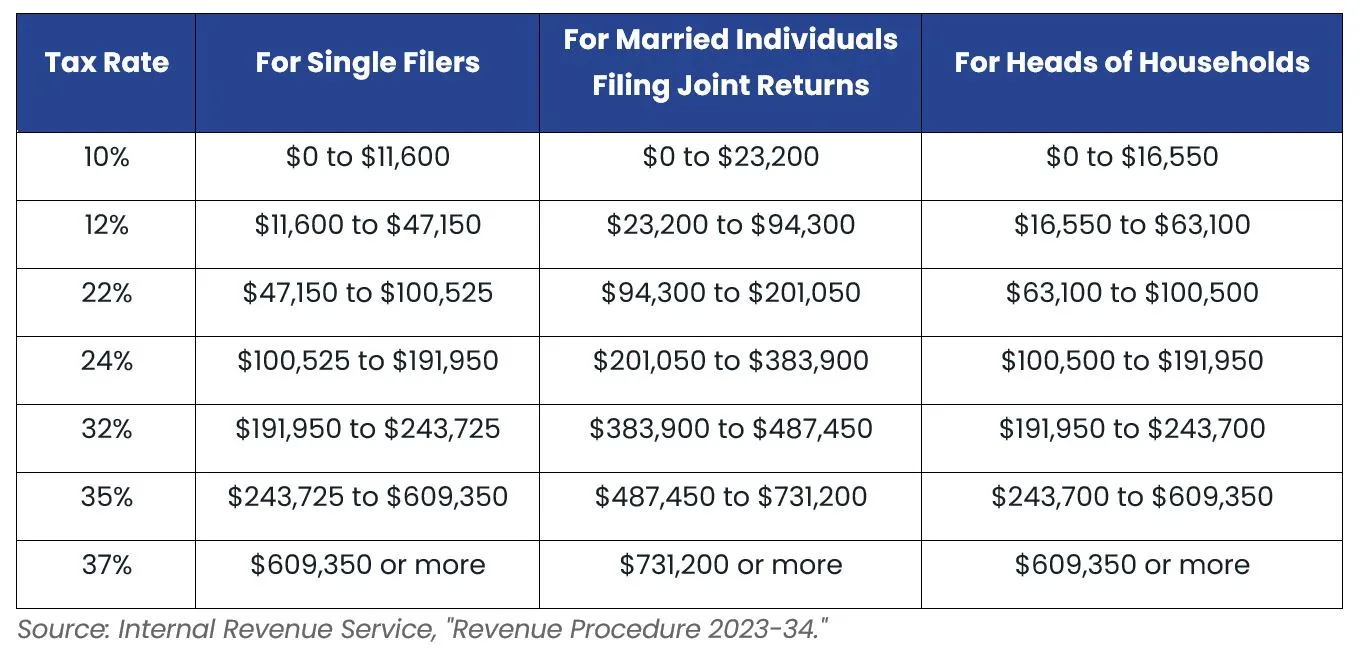
Standard Deductions
Standard deduction amounts have also increased:

Social Security Wage Limit
The Federal Insurance Contributions Act (FICA) requires companies to withhold three separate taxes from the wages paid to employees. The largest tax of these three is the Social Security, also known as the Old Age, Survivors and Disability Insurance Program (OASDI).
For 2024, the FICA tax rate for both employers and employees is 7.65% (6.2% for OASDI and 1.45% for Medicare) to be paid on the first $168,600 of wages in 2024. This is up from $160,200 in 2023.
$10,453 is the maximum amount of Social Security tax that will be deducted from an employee’s paycheck in 2024. This is an increase from $9,932 in 2023.
Supplemental Tax Withholding Rates
As standard for previous years, the supplemental Federal rate is 22% for those who make under $1 million remains unchanged, as does the 37% supplemental rate for those who exceed $1 million.
In Summary
As your relocation partner, NEI is here to explain year-end tax questions for your relocating employees. If you have any question about these changes, please contact Jaymi Stacy, NEI’s Sr. Director of Expense Disbursements, or your NEI Client Relations Manager at 800.533.7353.
This material has been prepared for informational purposes only and is not intended to provide, and should not be relied on for tax, legal or accounting advice. Please consult your own tax, legal and accounting advisors before engaging in any transaction.
How Global Economic Trends Are Driving Relocation
As the global economy shifts at an unprecedented pace, the role of global mobility managers is becoming increasingly complex and vital. Understanding the intricate web of free trade, technological advancements, and evolving workforce trends is crucial, given their profound impact on the nature and structure of today's work environment. This article explores the interplay between these variables and provides insights into their collective impact on job distribution and talent management.
Global Trade Dynamics and the Movement of Jobs
The last decade has witnessed significant shifts in global trade dynamics. While free trade fosters growth in total income at the country level, it also influences the distribution of jobs within and between nations.
A notable example is the United States, where manufacturing accounts for roughly 11 percent of total output and employs 8.4 percent of the workforce.1 Over the course of 40 years, the U.S. has seen a major migration of manufacturing jobs to countries with lower manufacturing wages. Manufacturing jobs have declined from 19.6 million in 1979 to nearly 13 million by November 2022, representing a 56 percent+ decrease when adjusted for population growth.2
As the manufacturing sector in the United States shrinks, this not only affects those directly employed in manufacturing but also results in a ripple effect, causing a substantial loss of jobs in secondary and tertiary industries. One study calculated that for every 100 jobs lost in durable manufacturing, 744.1 indirect jobs were lost through connections to sectors that provided materials for manufacturing and where manufacturing workers spent their income.3
Debate continues over the potential to restore these manufacturing jobs through policy changes, but the rising influence of technology and automation could irreversibly reshape the employment landscape in manufacturing.
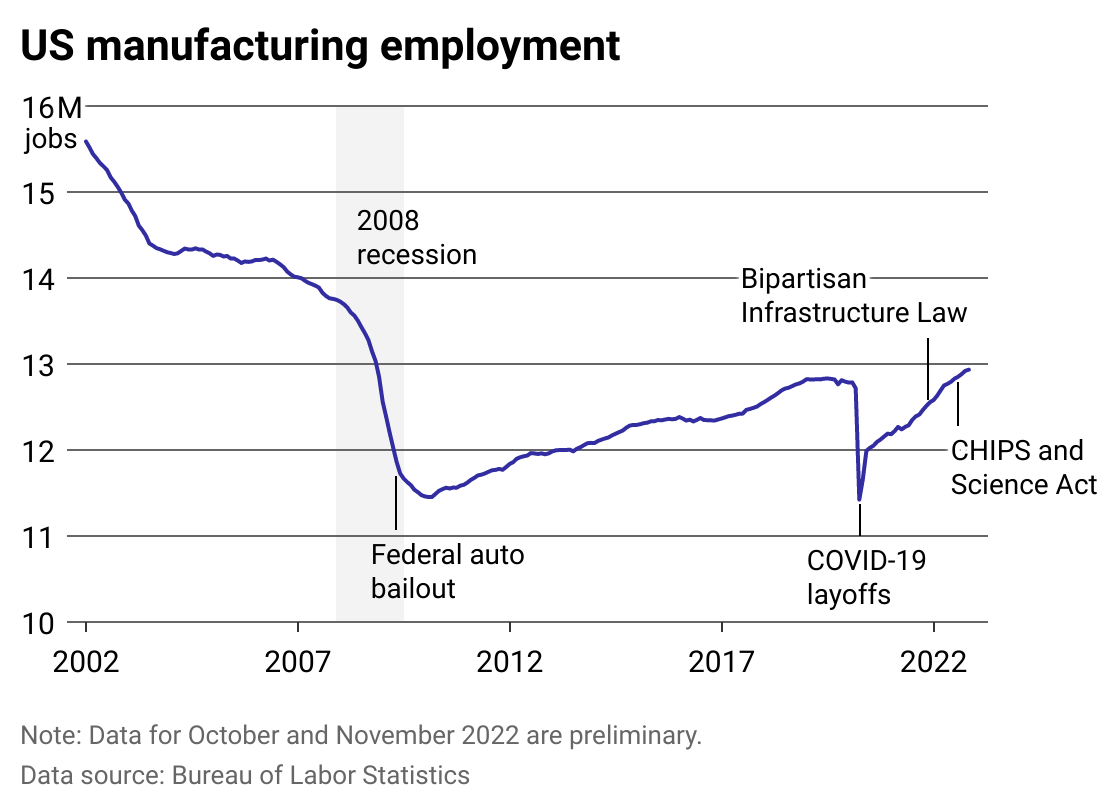
Technology's Role in the Changing Workforce
Automation in industries, especially noticeable in sectors like automobile manufacturing, have drastically reduced the need for human labor. A modern automobile factory now operates with significantly fewer employees than it did four decades ago. Additionally, as exemplified by a shift towards battery electric vehicles (BEVs) with simpler, less part-intensive plans, broader technological advancements in product designs have the potential to further impact manufacturing jobs overall.4
This shift, while diminishing the number of manufacturing jobs, has increased the demand for higher-skilled labor. Consequently, the compensation per job in the manufacturing sector has risen, reflecting the need for more specialized skills. A 2021 Deloitte study reports the U.S. is expected to have 2.1 million unfilled manufacturing jobs by 2030, citing that, with technological advancements driving efficiency and productivity, “companies are willing to pay top dollar for skilled workers who can help them stay competitive in the global market.”5
With organizations facing increased challenges incentivizing both existing employees and new skilled workers to accept roles that involve relocation, offering competitive and cost-effective relocation benefits can prove to be a useful tool.
Economic Trends and Predictions
The current state of the global economy presents a mixed picture. While some regions experience modest growth, there's an overarching trend of slowing economic activity. This slowdown is partly attributed to significant increases in interest rates, the Federal Reserve’s response to a burst of inflation not seen in decades. The tightening of financial conditions by central banks aims to temper this inflation but comes at the cost of slowing down economic growth.
Predictions for the near future include the possibility of mild recessions in some areas. In a recent interview with NEI Global Relocation, Doug Duncan, Senior Vice President and Chief Economist at Fannie Mae, stated,
“In the first half of next year, still it's close to a toss-up, but we still think there's likely to be a mild recession starting sometime in the first half of next year… Right now, growth is pretty good, but we think it's likely to slow into next year.”
The reasons range from rising costs of goods and services due to increased credit costs to dampened employment and income growth. “Even though the rate of inflation is falling, it's still positive and prices have not come back down to where they were,” Duncan continued. “Of course, the Fed is concerned about the pace at which wages rise, which can be a contributor to inflation. So, there's going to be this period of frustration as time needs to pass with inflation at or below 2% and real incomes rising faster than that for households to catch up.”
-NEI_Duncan.webp)
Such economic concerns have profound implications for global mobility, affecting everything from talent acquisition strategies to compensation norms.
In the face of economic uncertainties, companies are sharpening their focus on roles crucial for enhancing operational efficiencies, such as HR business partners, process improvement specialists, and supply chain strategists. By focusing on strategic planning and efficient process management, these professionals help businesses navigate complex challenges, ensuring smarter and more effective use of resources. Simultaneously, with inflation impacting living costs, companies may reassess their compensation strategies. This could involve not only offering competitive salaries to attract key professionals, but also tailoring benefit packages to address the specific concerns of a workforce grappling with economic instability, such as increased healthcare coverage or flexible work arrangements.
As businesses recalibrate their talent acquisition strategies in response to economic challenges, understanding demographic shifts is the next essential consideration, given their significant impact on labor market dynamics and workforce availability.
Demographics and Labor Force Implications
Shifting demographic trends, particularly in developed countries like the U.S., are significantly impacting the labor force and emphasizing the need for immigration and corporate relocation strategies. Between 2009 and 2021, the U.S. saw a significant decrease in fertility rates, dropping by nearly 15 percent from 66.2 to 56.3 births per 1,000 women aged 15-44, as reported by the Center for Disease Control.6 With the birth rate now below the replacement level, this trend points to a potential future decrease in the domestic workforce.
“The discussion of immigration is a flash point, but at some point there's going to have to be a realistic assessment of what it is that we would like to achieve,” conveyed Duncan. “We will not replicate our workforce absent immigration.”
That flash point may have been reached. Though Congress has traditionally capped the limits on annual H-1B visa numbers at 65,000, the program could significantly change in October 2024. The Department of Homeland Security U.S. Citizenship and Immigration Services (USCIS) published a 94-page Proposed Rule in October to modernize the H-1B program requirements beginning in October 2024.7
Talent acquisition professionals and relocation managers will have to balance workforce needs with shifting immigration policies, ensuring that their staffing and relocation strategies align with the evolving demographic environment and labor market demands.
Adapting Talent Strategies in a Rapidly Evolving Global Economy
The interrelation between free trade, technology, demographics, and economic health creates a complex backdrop for Global Mobility and Talent Management leaders.
In the manufacturing industry alone, jobs are likely to change significantly in the next five to ten years due to rapid technological advances, and the skills companies seek in their future workforce may evolve. Global Mobility and Talent Management teams, both in manufacturing and across all industries, will need to continually adapt, balancing the costs of relocation benefits with their effectiveness in recruiting and retaining employees who are requested to move.
Staying abreast of trends is essential for developing effective strategies for global talent mobility, workforce planning, and corporate relocation. In an era marked by rapid changes and uncertainties, global mobility and talent managers will remain critical to guiding organizations through future economic landscapes.
Sources:
- Maquiladoras, Mexico’s engine of trade, driven to navigate evolving demand, by Jesus Cañas
- Forty years of falling manufacturing employment, by Katelynn Harris
- Updated employment multipliers for the U.S. economy, by Josh Bivens
- The stakes for workers in how policymakers manage the coming shift to all-electric vehicles, by Jim Barrett and Josh Bivens
- 2.1 Million Manufacturing Jobs Could Go Unfilled by 2030, NAM News Room
- Crude birth rates, fertility rates, and birth rates, by age, race, and Hispanic origin of mother: United States, selected years 1950–2019 and National Vital Statistics Reports, January 31, 2023
- Modernizing H-1B Requirements, Providing Flexibility in the F-1 Program, and Program Improvements Affecting Other Nonimmigrant Workers
Navigating Changes in Corporate Relocation and Benefits
NEI recently completed our 2023 U.S. Domestic All Benefits Survey. The survey covered all components of a typical U.S. domestic program, including policy overview, origination/departure services, destination services, the home sale process, and tax assistance. The top participant industries were Manufacturing, Medical/Pharma, Technology, Energy & Utilities, and Oil & Gas. There were 224 participants and forty-five policy components included in the survey, the key takeaways focused on flexibility in mobility programs, economic impact of policy changes, an increase in the number of renters, and the addition of Diversity, Equity & Inclusion (DEI) options for relocating families.
Program Flexibility & Policy Structure
The survey indicates that more and more companies are responding to the ever-changing needs of employees and internal business units by including more flexibility in their policy structures. The 4-tiered policy structure is the most common way to meet these needs, which is a slight increase from 3 tiers in 2022.The usage of core-flex programs has also increased, as have lump sum-only programs, which have increased from 2% to 3% by offering incentives to lower-tiered employees.
Influx of Renters
Traditionally, it was common for companies to assume their higher-tier employees would receive home sale benefits as part of their relocation package. However, survey results show that companies have noticed an increase in higher-tier renters and have responded by adjusting their lease cancellation benefits, with executive-level rental finding assistance increasing from 53% to 56%. Lease cancellation reimbursement ordinarily equals up to two months’ rent, but our research shows that nearly 11% of companies offer up to three months’ rent, likely at the higher policy levels.
Because an increase in the offering of rental finding assistance has been noted and is consistent with the increase of lease cancellation benefits, NEI recommends that companies offer all employees rental finding assistance, regardless of housing status in the old location.
Economic Impact on Policy
Another factor influencing client decisions is the economic impact of policy parameters such as Loss on Sale, Cost of Living Adjustments (COLA), and Mortgage Interest Deferral Assistance (MIDA). Though the housing market is slowing slightly, Case-Shiller reports that prices are still increasing. While it is still possible for employees to experience loss, NEI recommends companies prepare an addendum to policy for unique or “one-off” loss on sale situations.
One question NEI kept in mind while preparing the survey was “Are more companies offering COLA and MIDA with the cost of living increasing and the mortgage interest rates climbing so much?”
According to the survey, the answer is not really. With the cost of living increasing everywhere, the use of COLAs has risen from 7% to 11%, which is a relatively small increase compared to the rise in living expenses, but the expectation is that usage could increase more in the coming years. Additionally, for MIDA, only 2% of companies offer it for their Executives and 1% for their Directors and VPs.
When considering implementation of a MIDA program, NEI encourages companies to consider the interest rate differential increase rather than the interest rate itself. While MIDAs of old used to impose an 8% minimum rate for eligibility, the differential was typically only 2-3%. Though rates are now still below that prior 8% threshold, we’ve seen an increase of nearly 5% for some homeowners who purchased around 2%. A more appropriate method would incorporate the MIDA based on a minimum differential vs. the rate.
Diversity, Equity & Inclusion
The Benefits Survey shows that companies are incorporating DEI into many aspects of their corporate structure, including their relocation programs. Because the most common reason for an unsuccessful or declined relocation is spouse/family issues, there has been a significant shift from career assistance to family acclimation services.
New to the survey this year, DEI benefits are now outlined by 9% of survey respondents, a trend that NEI expects will continue to grow. The most common type of DEI benefit is employee/family integration assistance (44%), followed by DEI-specific allowance (28%) and flex benefit options to meet any need (22%). Also noted by some was their desire to minimize the gap between homeowner and renter benefits, bringing more equity to their programs in that way. As a result, new home closing costs are being more frequently offered to former renters.
Looking to Stay Ahead of the Curve
In addition to the topics outlined above, one subject expected to receive even more attention in 2024 is the 2017 Tax Cuts and Jobs Act, which will either be extended or expire in 2025. If the Act expires and the excludability of some tax expenses is reinstated (e.g. household goods and final move benefits), companies may experience a decrease in tax gross-up expenses, lessening the burden of otherwise rising costs.
If you would like a copy of the 2023 U.S. Domestic All Benefits Survey in its entirety, please contact your NEI representative or click here.
AI is changing the world, the only question is, "How?”
It's hard to overstate what “work” means to humanity—it's an integral part of what we do. A defining characteristic. From chariots to cathedrals, currency, jet planes, and colliders, our hunger for innovation is plain as day. But will our pursuit of technological advancements lead to further flourishing, or will we work ourselves out of a job?
Nearly every major advancement in technology has taken jobs away, but has made many more. The printing press, electricity, automobiles, the Internet, etc. Yet this time, maybe for the first time, we can see a future where human work has actual competition.
What does it mean for operators in shipping sectors when self-driving trucks can drive further, safer, and cheaper than human counterparts? Or for financial professionals when programs are able to analyze, appraise, and execute transactions with higher yields and lower risk in a fraction of the time? What does it mean for all of us? Will we fashion AI into the ultimate servant of our leisure and let it replace us entirely, or will we wield AI as a master tool to solve problems we never could before?
Our creativity is undefeated, but our resolve will be tested. For us to live productively at peace with AI, we must first know what it is.
Getting Our Definitions Straight
Artificial Intelligence (AI), in its broadest sense, encompasses any machine or software that mimics human intelligence. For instance, the ability to learn, perceive, reason, comprehend language, and problem-solve. As technology advances, AI's capabilities have expanded from simple algorithms to complex systems capable of autonomous decision-making and incredible displays of knowledge.1
For example, planes use to be rudimentary, mechanically operated vehicles protected mostly by skilled pilots. These days, modern commercial aircraft house AI powered flight controls, collision avoidance, weather prediction and avoidance, air traffic management, and terrain/obstacle avoidance systems—all basically standard.2
Machine Learning (ML), a crucial subset of AI, involves algorithms that learn from and make predictions or decisions based on data. Deep learning, an advanced form of ML, is patterned off of neural networks and sends data through multiple layers of analysis to develop comprehensive familiarity with the data set or subject matter. We have used forms of Artificial Intelligence for some time now, but what's new is AI's ability to produce original and detailed outputs with a high degree of usefulness and accuracy.3 This is known as Generative AI (GenAI) and represents the vanguard of our progress thus far.
What Lies Beyond Generative AI?
I'm glad you asked.
The answer to that question is Artificial General Intelligence (AGI). As Dr. Jeremy Kedziora, Endowed Chair in AI at the Milwaukee School of Engineering, explains:
“Artificial General Intelligence is like the holy grail of computer science. An AGI would be a kind of A.I. that would be self-adaptive, self-learning, able to do any task as well as or better than a human can do. It doesn't necessarily mean that an AGI would be conscious, it just means that it's very, very capable, and doesn't have any need for human intervention.”
As cool as it might be to have such a system operational in our world, for now it remains a goal for the future. Current AI systems are considered narrow or weak AI, designed for specific tasks, such as voice recognition or image analysis. But with the advent of Large Language Models (LLMs) like OpenAI's ChatGPT, a generative language system that can understand and generate human-like text, it's clear that today's AI systems are getting stronger every day.4
“Once developers can generalize a learning algorithm and run it at the speed of a computer—an accomplishment that could be a decade away or a century away—we’ll have an incredibly powerful artificial general intelligence,” said Bill Gates. “It will be able to do everything that a human brain can, but without any practical limits on the size of its memory or the speed at which it operates. This will be a profound change.”5
AI effectiveness and reliability is highly dependent on the data it consumes. Biases or errors in training data can lead to skewed AI behavior, reflecting human prejudices and failings. This duality in AI capabilities—reproducing both our ingenuity and our flaws—underscores the need for responsible AI development, focusing on ethical training practices and diverse data sets.6
AI's potential is vast, but its real-world applications are currently bound by technological limitations, ethical considerations, and practical feasibility. The progression towards AGI, if at all achievable, requires not only technological breakthroughs, but also a profound understanding of human cognition and ethics.7
How Will AI Impact What We Hire For?
The interplay between evolving AI capabilities and human adaptability is reshaping the workforce landscape. Jobs involving routine, repetitive tasks or those heavily reliant on data processing are increasingly subjected to automation through AI. Clerical work, data entry, and aspects of manufacturing are seeing a shift towards AI and robotics. However, this technological disruption is not merely about job replacement but also about transformation and creation of new roles.
For example, AI in healthcare8 is not only automating administrative tasks but also augmenting medical professionals' abilities in diagnosis and patient care. AI tools are assisting radiologists in detecting anomalies in imaging scans more accurately and swiftly than before.9 Kedziora, in speaking on the matter, adds:
“A doctor, a med student, or a resident standing at a patient's bedside doesn't have to keep in memory a hundred different physical signs of something. They can offload some of that work because that's just beyond the ability of anybody to do it effectively. We have these kinds of things going on right now.”
Integration of AI necessitates an evolution in the skill sets required for the workforce. Jobs will increasingly require a blend of technical proficiency and soft skills like problem-solving, creativity, and emotional intelligence. AI literacy will become a crucial skill across various sectors – not just for IT professionals.
“The AI genie is out of the bottle,” said Cynthia Breazeal, a professor of media arts and sciences at the Massachusetts Institute of Technology. “It’s not just in the realm of computer science and coding. It is affecting all aspects of society. It’s the machine under everything. It’s critical for all students to have AI literacy if they are going to be using computers, or really, almost any type of technology.” 10
The changes extend beyond individual job roles to affect team dynamics and organizational structures. AI tools will act as collaborators, aiding human teams in achieving greater efficiency and innovation. This shift in workplace dynamics also brings into focus the need for ethical considerations and governance in AI deployment.
Future hiring practices will likely emphasize a candidate's adaptability and capacity to work alongside AI. Similarly, professional education and training programs will need to adapt, preparing individuals for a future where AI is an integral part of the work environment.
How Should You Think About AI and Your Industry?
Understanding AI's potential impact on an industry requires analyzing current technological integration and the nature of work involved. For instance, manufacturing has already seen significant automation with robotic assembly lines, so further AI integration, while likely, will not have the same impact as in other sectors. In contrast, creative industries like advertising or software development, traditionally reliant on human ingenuity, are beginning to experience AI's influence in generating content and coding.
AI should be viewed as a toolset tailored to specific challenges and opportunities rather than a one-size-fits-all solution. It requires human oversight to identify process inefficiencies and engineer AI solutions that address specific needs. Industries must evaluate their unique contexts to leverage AI effectively, fostering a workforce that can synergistically work with AI.
Another example is in retail, where AI can improve customer experiences through personalized recommendations and efficient inventory management. However, it should be noted that while humans appreciate the many positives that AI can offer, in many instances customers prefer to retain a human element—especially when it comes to customer service and decision-making.11
To prepare for AI's future role, companies should assess their operational challenges and opportunities, investing in AI technologies that align with their strategic goals. Developing a workforce skilled in AI integration and adaptation will be crucial in leveraging AI's full potential.
A Word on Relocation
The rise of AI is not only transforming job roles and industries, but it’s also reshaping the global workforce landscape. Companies are increasingly focusing on recruiting talent that is proficient in creating and using AI solutions. This shift is influencing where companies choose to operate and the nature of their workforce.
AI-driven technologies like telecommuting, virtual collaboration, and autonomous vehicles are changing the dynamics of work location and commuting. For example, the advent of self-driving cars could make longer commutes more tolerable, potentially affecting urban planning and housing markets.12
The globalization of the workforce, facilitated by AI and digital technologies, is leading to more diverse and geographically dispersed teams. This decentralization offers companies access to a broader talent pool, but also presents challenges in managing a remote workforce.
AI's influence extends to how individuals consider job opportunities. Technologies like advanced AI voice translation devices could reduce language barriers, encouraging more people to consider international assignments. Similarly, AI's role in making travel safer and more efficient could influence decisions related to travel-intensive roles.
In this evolving landscape, companies must strategically consider the makeup of their workforce, the location of their operations, and how they can best leverage AI to maintain a competitive edge. The future of work will likely be characterized by increased flexibility, with AI playing a pivotal role in enabling this transformation.
Balancing Human Creativity and Machine Intelligence
“There are two types of companies: those who are great at AI and everyone else.” ~ Marc Cuban
AI is a transformative force reshaping the environment of work and industry. Its impact extends beyond technological advancements to influence hiring practices, workplace dynamics, and even the global distribution of work.
As we integrate AI into various aspects of our professional lives, it is crucial to balance its potential with ethical considerations, ensuring that technology enhances rather than eclipses the human element in work. Because the future of AI in the workplace is not just about automation and efficiency: it's about harmony and crafting the right relationship between human creativity and machine intelligence.
In every era technological advancement challenges us to adapt, and especially so in this current time. The odds are in our favor. But make no mistake, our imagination stands at the helm of our response and will decide our future. Will we rise to the challenge and test its bounds, or will we allow AI to lull us into complacency?
It's yours to decide.
Sources:
- Understanding artificial intelligence ethics and safety, by The Alan Turing Institute
- Fly to the sky! With AI. How is artificial intelligence used in aviation? by Artur Haponik
- The future of work after COVID-19, by McKinsey & Company
- How remote work is reshaping America's urban geography, by Brookings Institution
- The Age of AI has begun, by Bill Gates
- Artificial Intelligence and Life in 2030, by Stanford University
- Artificial General Intelligence: Concept, State of the Art, and Future Prospects, by Journal of Artificial General Intelligence
- Artificial Intelligence in healthcare: past, present and future, by BMJ Journals
- How Is AI Used In Healthcare - 5 Powerful Real-World Examples That Show The Latest Advances, by Bernard Marr (Forbes)
- AI Literacy, Explained, by Alyson Klein
- I Stats News: 86% Of Consumers Prefer Humans To Chatbots, by Gil Press (Forbes)
- Autonomous driving’s future: Convenient and connected, by Johannes Deichmann, Eike Ebel, Kersten Heineke, Ruth Heuss, Martin Kellner, and Fabian Steiner
Global Mobility Leader Achieves Top Rankings in Willingness to Recommend and Continuation of Services
NEI Global Relocation proudly announces its outstanding performance in the 22nd Annual Relocation Managers Survey© conducted by Trippel Survey and Research, LLC. Demonstrating unparalleled commitment to excellence, NEI has secured the top position in the highly coveted categories of Willingness to Recommend and Continuation of Service, reaffirming its status as a premier Relocation Management Company.
#1 Willingness to Recommend
“It means a great deal to us that our clients feel comfortable and even excited to recommend us to their peers in the industry.” Randy Wilson, President and CEO of NEI Global Relocation, remarked. “We try very hard to pursue collaboration with quality clients that align with our culture of excellence, so to have those same people willingly advocate for our services speaks volumes.”
Commenting further, Wilson expressed, “This recognition reinforces our belief in the power of genuine relationships and the impact of delivering exceptional relocation experiences. We see it as a validation of our commitment to not only meet but exceed expectations, and it motivates us to continuously elevate our standards. We are grateful for the confidence our clients place in us and are dedicated to maintaining the level of service that inspires such positive recommendations.”
#1 Continuation of Service
In speaking on receiving the top ranking for Continuation of Service, Wilson commented, “It’s incredibly satisfying to see the deep trust our clients place in our services and the dedication of our team to uphold the highest standards of excellence. It not only validates our commitment to excellence but also reinforces our resolve to innovate and adapt in an ever-evolving industry. This especially isn’t just an honor; it's our motivation to continue forging productive relationships and delivering unparalleled service for those in our care."
The dual triumphs in Willingness to Recommend and Continuation of Service solidify NEI Global Relocation's position as a trusted partner in global mobility. In securing top marks across various key metrics in the 22nd Annual Relocation Managers Survey©, NEI Global Relocation demonstrates steadfast dedication to service excellence and client satisfaction. This consistent high performance, recognized broadly in the industry, reinforces NEI's commitment to provide reliable and first-rate relocation services.
About NEI Global Relocation
NEI Global Relocation is a leading Relocation Management Company, providing comprehensive global mobility solutions. With a commitment to excellence and a focus on building lasting client relationships, NEI ensures seamless employee relocations worldwide. For more information contact your NEI representative or click here.
Competition & Chaos: Navigating Relocation and the Paris 2024 Summer Games
Corporate Global Mobility, Human Resources, and Business Managers should prepare for potential challenges that employees and businesses will face both before and during the 2024 Olympic and Paralympic Games held in and around Paris, France.
The Roar of the Crowd
• The Olympic Games run 26 July – 11 August 2024.
• The Paralympic Games run 28 August – 8 September 2024.
• The Olympic and Paralympic Games will take place in nearly three dozen sites in and around Paris.
Weeks before the games start, over 15,000+ athletes, 30,000+ volunteers, and 6,000+ members of media will descend on the Paris area. During the games, an estimated 13 million spectators will attend.
Paris is already one of Europe’s busiest tourist destinations. In fact, the city was so overcrowded in the summer of 2023 that the French Tourism Minister requested visitors stay away from popular tourist attractions in the city and check out other areas of the country.
In addition to the surge in pre-games preparation and ongoing games activity, intense security will also be a factor. Business Travelers and Employees on assignment in Paris will face significant challenges leading up to and during the games. These could include finding temporary or permanent accommodations, longer commute times while navigating crowded public transportation, and delays in simply conducting business.
Go for the Gold in Relocation Guidance
Proactive planning, open communication, setting expectations, and flexibility in work arrangements can help mitigate these challenges and ensure a smooth transition during this hectic, exciting time.
NEI’s service partner, Dwellworks, and their local experts in France recently provided sound “What to Expect” guidance about how to secure accommodations and navigate travel/traffic issues around the Paris Summer Games:
What to Expect:
Booking Well in Advance
Several providers have acted early in removing their inventory from Global Distribution Systems (GDS) during the Olympic and Paralympic Games as a way to control their inventory and maximize booking opportunities during this time.
Inflexibility
Clients should be aware of the risk of block bookings as sales are often final, with providers historically being unwilling to negotiate terms for unused inventory, cancellations, deposits, etc.
Stay Requirements
It is expected that minimum/maximum stay requirements will likely be enforced during this time period. It is highly recommended to secure your Games accommodation sooner rather than later.
Stringent Cancellation Terms
Cancellation terms will likely be far more stringent and are expected to include increased cancellation periods, as well as non-refundable terms, both before and during the Olympics/Paralympics Games period to avoid speculative reservations and to maximize opportunity for providers.
Higher Deposit Requirements
Down-payment/deposit requirements are expected for all parties; it is highly likely that group/block bookings will be required to pay a deposit at a premium rate. Booking rates are expected to increase by 120%, lower rates will return before and after the Games.
Increased Traffic
Residents and visitors can expect every hour to be similar to rush hour during the Paris 2024 Games. The anticipation of several million tourists travelling to Paris during the Games most likely will cause traffic congestion and overcrowded public transportation as well as limit the availability of ride-sharing apps. It is recommended to travel via bike or walk when possible.
Global Relocation & The Olympics
Mark Spitz, an American swimmer and 9-time Olympic medalist, famously said: “If you fail to prepare, you’ve prepared to fail.”
To avoid delays, we encourage clients to prepare and plan accordingly with both their business units and relocating employees.
Please reach out to NEI in advance of employees relocating to or from any part of France in the spring or summer of 2024. Proactively, NEI and our partners can look at each unique situation and conduct advance research to determine potential challenges and find alternative options.
NEI will continue to provide clients with updated information about how the Paris Summer Games might impact global mobility in and out of France and how to manage employee expectations accordingly.
If you would like to discuss this situation further, please reach out to your NEI representative or NEI’s VP of International Services, Mollie Ivancic.
The text above is provided for informational purposes only. Please consult your tax, legal, immigration or accounting advisors before making any decisions or transactions.
Protecting Renters: Avoiding Junk Fees and Spotting Scams
Apartment shopping can be stressful enough, but in today’s marketplace scammers and crafty custodians can lead to a financial maze with potentially disastrous results. This is why professional rental assistance can be so valuable.
New Rental Reality – Uncovering Hidden Fees
Median national rent prices continue to sit well above pre-pandemic levels, having risen by more than 18.5 percent in three years, and now account for 30 percent of the average American household income.
Hidden 'junk' fees and rental fraud make it difficult to accurately estimate the true cost of an apartment – especially when using different search engines online. These additional fees typically range from $5 to $50, which may seem insignificant, yet can add up with multiple line items to more than tenants budgeted for, as reported by The Wall Street Journal.
What makes the charges hard to contest is their attachment to specific services such as rent processing, trash removal, mail sorting, parking, pets, "January Fees" (an added charge in some states on the first month of the year with no apparent benefit to tenants) and even “convenience” fees to collect tenant’s rent online…which is a convenience for landlords.
Enhancing Rental Transparency
Beyond the obvious financial implications, the lack of transparency associated with these fees can mislead renters into choosing an apartment they believe is affordable, only to discover unexpected costs. Even before the pandemic, over 20 million renter households expressed concerns about housing costs jeopardizing their financial stability, according to a March report by the National Consumer Law Center.
In response, the White House took steps to enhance transparency and several online platforms have agreed to work towards disclosing all fees. Examples of efforts include:
- Zillow.com plans to display a "cost of renting summary" on its active apartment listings, summarizing all additional fees.
- Apartments.com will introduce a calculator to help renters determine the total cost of renting an apartment.
- AffordableHousing.com will ensure owners disclose all refundable and nonrefundable fees upfront in their listings.
These tools aim to make apartment hunting more transparent, allowing individuals to compare options and reduce uncertainties.
Application Fee Awareness
Prospective renters often contact multiple owners or property managers and visit several places during their housing search. Each rental application entails a fee, ranging from $50 to hundreds of dollars. This is supposedly to cover office work and background/credit checks. In a tight rental market, applicants frequently apply to multiple properties, and inaccuracies in tenant screening reports can lead to repeated rejections – despite multiple application fees paid.
The White House's recent crackdown on "junk fees" also aims to shed light on these additional application costs, aligning efforts to also address extra fees assessed by airlines and live-event platforms.
The hope is that by making all fees public, fewer apartment complexes/landlords can surprise tenants and tenants will be better equipped to make fair comparisons between rental options while searching for a place to live.
Recognizing & Avoiding Scams
Sadly, rental fraud is also on the rise. According to a recent survey conducted by Dwellsy, around 85 percent of responding renters experienced financial losses as a result from rental fraud above $400 and 19 percent experienced losses of more than $5,000. Over 60 percent of respondents reported encountering suspicious activities on digital rental platforms, such as fake landlords trying to steal a rental payment or deposit.
To secure a fair and transparent rental agreement, awareness is crucial. Scam signs include:
- Photos look too good to be true
- Listing has grammatical/formatting errors
- Pressure to sign the lease or send money prior to touring
- No credit check required
Using a qualified rental finding partner who understands the local market helps tenants steer clear of unwelcome surprises. Scams can further be avoided by:
- Always requesting a tour
- Avoiding sending money by wire
- Asking to speak with the property owner/manager
- Disregarding listings that look/feel suspicious
Through programs like Extended Rental Assistance, NEI works directly with qualified rental finding partners – giving each agency both verbal and written guidelines outlining the anticipated needs of relocating employees, setting expectations, specifying timelines, and reporting protocols for the rental search. Following the agent's initial engagement with the transferring family, additional follow-ups between NEI and the partner occur during and after the rental finding trips. As always, communication is maintained with the employee through the lease finalization process.
In Summary
Renting an apartment can be complex, but being equipped with the right knowledge is critical to making it a stress-free process.
New tools from platforms like Zillow, Apartments.com, and AffordableHousing.com will undoubtedly aid employees, however, having multiple options, back-up plans, and working with a trusted rental-finding agency can make all the difference in ensuring successful employee transitions.
Ensuring the peace of mind and productivity of our clients’ employees remains our top priority. NEI’s Client Relations Managers work with each of their clients to discuss the most cost-effective approaches available. If you would like to discuss this or other relocation trends or cost-saving solution ideas, please reach out to your NEI representative.
This material has been prepared for informational purposes only, and is not intended to provide, and should not be relied on for, tax, legal or accounting advice. You should consult your own tax, legal and accounting advisors before engaging in any transaction.
10 Things That Will Surprise You When Relocating to Dubai
Dubai continues to rise in popularity when it comes to international relocation and global mobility. Whether it is its reputation for safety, its unique business opportunities or its year-round sunshine, there are so many attractive elements about the city that keep drawing in new people every day.
If you want to know more about this in demand destination, click here.
NEI is proud to feature how our service partners support your employees and their families as they relocate and transition to all points of the globe. EER Middle East is the region’s leading supplier of relocation, immigration and corporate services in Saudi Arabia, Bahrain, Qatar, Oman, Kuwait and the UAE.
National Association of Realtors Found Liable
On October 31, 2023, a jury reached a decision that could potentially change how real estate transactions are conducted in the U.S., creating opportunities for significant changes to commissions paid to real estate agents. In the case, Burnett v. NAR et al, the Kansas City, MO, jury found the National Association of Realtors (NAR), and some of the largest national real-estate broker franchisors conspired to artificially inflate home-sale commissions.
The basis of the conspiracy is the condition that a home seller must agree to pay a commission to the buyer’s agent before the home can be listed on NAR’s nationwide Multiple Listings Service database – a database controlled by local NAR associations. And, since most home sales are through the MLS marketplace, the plaintiffs claim home sellers are forced to pay a cost that should be paid by the buyer.
Under the new model, sellers may no longer be responsible for covering the seller’s and buyer’s agents’ commissions, allowing negotiation of different compensation models, and having buyers assume the responsibility of directly compensating their agents.
The NAR believes this could be a substantial challenge for first-time and low-income buyers who might lack the upfront funds to pay an agent, potentially depriving them of valuable expertise.
According to Worldwide ERC, the resolution of this and other related lawsuits could potentially change today’s real estate business by bringing competition, cutting costs, and providing customers with more options.
With uncertainty on how the ruling plays out, and NAR planning to appeal the decision with confidence, NEI will continue to monitor the situation and will offer updates as they become available. If you have any questions, please contact your NEI Client Relations Manager or NEI Client Development Contact at 800.533.7353.
The Basics of International to U.S. Relocations
Managing an international employee’s relocation to the U.S. for a company-sponsored assignment or permanent move may seem straightforward, but overlooking details can result in delays, frustration, and added costs to an already expensive proposition.
What is important to succeed?
Ample planning – ideally 12 months – for relocations into the U.S. is encouraged today. This involves everything from coordinating visa/immigration needs to housing, household goods shipments, family challenges and more. Running cost estimates before employees are presented their relocation offer is wise, as is using professional pre-offer candidate assessments to confirm candidates have “the right stuff” to succeed. These range from self-administered tests to in-depth assessments and prediction models.
Second, it’s a best practice to cost-effectively manage international relocations to the U.S. using an experienced global Relocation Management Company (RMC) to coordinate services with vetted global suppliers and ensure cross-border compliance.
Finally, consistent, competitive inbound-U.S. employee relocation benefits policies are critical to support business drivers, cultures, and budgets. Employees should receive proactive guidance from the RMC’s dedicated Counselors to maximize benefits. Counselors are employee advocates and expertly manage the entire process.
Key Areas of Support
Families of relocating employees are often excited at the prospect of moving to the U.S., but that excitement can turn to apprehension in the following areas:
Visa/Immigration
Completing all required visa/immigration applications is key to scheduling U.S. arrivals. The RMC can manage this process with immigration experts. It is critically important to start the application process much earlier than in years’ past and to set realistic timelines. Immigration processes are now more complex and non-compliance penalties for employees reporting for work in the U.S. before work permits are secured may include fines and/or being banned from entering the U.S. for between three and ten years. Twelve months is the recommended time span to begin the process.
Employee/Family Integration
Integration can be daunting. Expats often report each of the 50 U.S. states feel like their own separate country with unique cultures, climates, regulations, dialects, and more. To ensure international employees to the U.S. are productive from the start, pre-departure intercultural and/or language training helps them live and work confidently – especially in areas without large expat populations.
Household Goods
RMC partners can arrange full moving services – from packing, crating, steel container loading, and shipping to unloading and unpacking in the U.S. Moving companies and freight forwarders in each country coordinate with the RMC to manage customs/port delays in the U.S. or the departure country and track shipments. This involvement saves employees stress and companies money.
Housing and Settling-In
Employees entering the U.S. require professional home finding services. RMCs work directly with local Destination Service Partners (DSP) to view U.S. properties, assess leases for appropriate terms, verify rent fits within the housing allowance, and so forth. DSPs also help with settling-in by arranging utilities/internet connections, establishing U.S. bank accounts, and orienting to local shopping, schools, and hospitals.
School and Spouse/Partner Support
School safety and academics are a top family concern when considering a U.S. relocation, so company-sponsored access to professionals who can identify destination solutions is encouraged. Accompanying spouses/partners who left careers and family behind, or perhaps find everyday tasks in the U.S. overwhelming, can impact the success of a U.S. relocation. Offering upfront, professional support can effectively overcome these obstacles.
Coming to America
Overlooking details or cutting corners when relocating international employees to the U.S. can risk non-compliance penalties and failed assignments, but also negatively impact valued talent who view the moves as significant career or growth opportunities.
Proactive, start-to-finish assistance and attention to detail directly supports international employees’ successes and companies’ business goals.
Top Global Mobility Risk Mitigation Challenges for Corporate Relocation
International assignments are integral components of many companies’ global growth strategies, but with such global growth comes risks that can keep corporate mobility managers up at night.
A Dynamic Global Mobility Landscape
The landscape of global mobility risk is complex and filled with potential potholes on the road to an employee’s successful international assignment. Political instability, security concerns, and/or health and safety issues are some of the top challenges employees and their sponsoring employers may face.
Addressing issues surrounding corporate global relocation risks requires a proactive, honest, and detail-oriented approach. It is critical corporate managers overseeing employee international assignments are knowledgeable and empowered from within and form close, collaborative partnerships with experts. This will help them navigate hazards with confidence and ensure the well-being of their employees and the duty of care obligations of their employers sending them.
Consider the top risks and ways to mitigate them:
Security
Terrorism, crime, geopolitical tensions –each pose unforeseeable dangers. Progressive companies will implement comprehensive security assessments and threat analysis to identify vulnerabilities and develop targeted risk mitigation strategies. Employee training on situational awareness, personal safety protocols, and emergency response procedures should be conducted. For clients, leveraging cutting-edge technologies such as online dashboard “heat maps” to show company employee / business travel assignment locations and cybersecurity protocols enhances online security to monitor and respond to potential threats in real-time.
Political Instability
To address political instability, global mobility managers must see the importance of staying ahead of political risks. They build networks of local partnerships and leverage geopolitical experts to gain valuable insights into the countries and regions where employees are assigned. By developing crisis contingency plans and protocols, they can respond quickly to political shifts, ensuring the safety of employees and the continuity of operations.
Health and Safety
Pandemics, natural disasters, employee medical conditions, on-assignment emergencies and more demand meticulous preparation. Proactive risk management involves developing crisis response plans, integrating remote monitoring systems, and ensuring access to telemedicine. By conducting pre-assignment medical assessments, organizations can identify any pre-existing health conditions and provide continued, appropriate on-going assignment support and resources. There are also options available for medical insurance coverage to consider such as:
- Employer-sponsored health insurance: comprehensive plans for employees provided with employment; covering medical expenses. Includes check-ups, emergencies, hospitalization, and dental/vision.
- International private health insurance: individual plans for global medical expenses; covering inpatient and outpatient services, emergencies, and medical repatriation.
- Travel insurance: May provide limited coverage for emergencies, accidents, and medical repatriation, but there is usually a limit for travel insurance policies and how long one can be living in a foreign location; companies should understand all policy limitations.
Crisis response and emergency evacuation plans are often overlooked in the overall planning of a move, but doing so is essential. Doing so during a crisis is not the time.
Regularly monitoring and checking in on employees’ well-being on assignment – regardless of their location – is also best practice and NEI regularly checks in with employees during their assignments for clients.
Collaborative Relocation Services Partnerships
By forging strong, mutually supportive partnerships with NEI Global Relocation, risk consultants, expert global security firms, global emergency evacuation companies, as well as local authorities, companies will gain access to invaluable expertise and worldwide resources.
Sharing best practices through industry collaborations and information-sharing networks further strengthens risk management efforts. Engaging in 24/7 open lines of communication with employees creates a culture of safety and empowers employees to be active contributors in risk mitigation.
Collaborative partnerships also foster a sense of mutual support and shared objectives among global mobility stakeholders. By combining resources, knowledge, and expertise, companies can effectively address complexities surrounding global mobility risks and strengthen both their operations resilience and the well-being of their employees during a global assignment on the company’s behalf.
Global Relocation Duty of Care Responsibility
As organizations expand around the world and send employees to locations for permanent work or temporary projects, each employer has an obligation to safeguard their mobile workforce. The Duty of Care concept includes a legal, ethical and moral obligation to reduce risk and provide the elements for a safe environment for employees during their global relocations or assignments.
By prioritizing Duty of Care, companies can demonstrate their commitment to not only individual employee / family welfare, but a commitment to conducting thorough risk assessments, implementing proactive security measures and developing robust health and safety protocols. Integrating Duty of Care principles and strategies into risk mitigation strategies, companies can foster a culture of employee safety and well-being.
Transform Risk into Opportunity
NEI believes risk management is essential for protecting both employee and company interests and for navigating the complexities of global mobility.
Organizations can transform risks into opportunities for growth, innovation, and sustainable success. By embracing risk management and mitigation practices, HR professionals can steer through the various, fluid challenges of international moves and assignments with confidence and help ensure the success of their organizations’ goals and projects.
If you would like to discuss policy change, risk mitigations or duty of care or any other topic impacting your global relocation programs, please reach out to your NEI representative.
Supporting Stressed Out Relocating Employees Today with Ease
Employees on the front lines of customer service across the United States feel that bad behavior from the public is more common today than before COVID and that insults, rants, and rudeness are on the rise. Why is this happening more and how can it be best dealt with?
Post-pandemic Incivility
Any customer service professional knows they are likely to encounter a rude, impatient, or irrational customer among the countless pleasant and professional ones served. In the latest National Customer Rage Survey, 17 percent of Americans admitted to being uncivil in interactions with businesses.
Nevertheless, the frequency of irritable people seems clearly on the rise compared to the past. This could be attributed to more people reporting lower levels of sleep, exercise, and self-care and higher levels of stress, daily costs and being time-starved. In fact, Americans who want more time in their lives are happier than those who want more money, according to the journal Social Psychological and Personality Science.
The phrase “Everyone has a Microphone” captures the inclusiveness of online communications in today’s hyper-digital age, but it also enables people to use more harsh language behind a keyboard than if the same interaction was face-to-face, for instance. Psychologists feel technology, despite its many benefits, can sometimes lead to human disconnection when a human touch is needed most.
After all, according to a Harvard Business Review article “Frontline Work When Everyone is Angry,” the average person takes in considerable amounts of negativity online each day – both consciously and unconsciously – and the content one consumes not only affect ourselves, but others too.
A strong relocation management partner will appreciate that moving can be a stressful life event for employee/family customers. Patience and empathy, as well as turning any negative encounters into opportunities for growth and positive outcomes, are the difference. Consider the following service tactics.
A Deeper Empathetic, Service Mindset
Simon Sinek once said, "Communication is not about speaking what we think. Communication is about ensuring others hear what we mean."
Understanding and acknowledging emotions behind a customer’s anger or impatience is key to addressing their concerns in a positive manner. It may be difficult and feel contrarian to do so in the moment, but seeing a situation through a customer’s eyes, acknowledging their frustrations, and making them feel heard can change the tone of a conversation and create calm.
This begins by hiring the right people and preparing front line professionals for success. Prepping front line team members to handle challenging customer interactions requires intentional efforts and, through workshops and role-playing exercises is necessary to learn to respond calmly and confidently-- even in the rare occurrence of hurtful verbal abuse.
Active listening, positive language, and clear expectations are the pillars of impactful communication
and communicating effectively can turn tense situations into opportunities for resolution.
"My Account Executive makes you feel very welcome and that she always has time for you. Even when my husband was getting feisty with her over something that was NOT in her control, she maintained her professionalism and even harder, her cheery attitude. Not many people can do that...”
~ NEI Client Relocating Employee Customer
Tailoring Solutions to Relocating Employees
American technology executive and writer Sheryl Sanberg said, “Leadership is about making others better as a result of your presence and making sure that impact lasts in your absence.”
Understanding different customer archetypes is akin to decoding a puzzle and each requires a unique approach. Whether it's addressing the impatient, building trust with the angry, or exceeding expectations of perfectionists, tailoring approaches leads to greater customer satisfaction.
Maintaining a professional, empathetic equilibrium fosters resilience to oversee difficult customer situations successfully and enabling companies to deliver service with a tailored approach for each individual. For instance, if a customer is curt or abrasive, it’s important to recognize they want the customer service representative to get straight to the point. Likewise, other relocating employee customers need to build trust with their representative and may need extra time to open up or discuss certain topics.
In every relocation management professional's service skills kit, identifying potential protection concerns and assessing when a client or management should intervene is paramount for protecting the customer service representative and team.
Finally, implementing instant and regular satisfaction and feedback mechanisms allow customer service companies, like NEI, to gauge the effectiveness of strategies and make data-driven decisions to enhance customer service efforts.
“My Account Executive was the brightest spot…available, understanding, kind, always quick to reply and help find solutions…She was always there to provide support, peace of mind and a ray of sunshine.”
~ NEI Client Relocating Employee Customer
Rudeness: Like the Common Cold
Research reported in the Harvard Business Review shows rudeness may be like the common cold: “It’s contagious, it spreads quickly, anyone can be a carrier — at work, at home, online, or in our communities — and getting infected doesn’t take much.”
Yet, with a positive mindset – and by embracing patience, empathy, and effective communications – global relocation management professionals can transform challenging customer interactions into positive, lasting impressions and success stories.
Proactively counseling relocating employees is more than just connecting at key touch points. It’s also about appreciating and managing the emotional ups and downs of relocating. It’s about doing so with calm, grace, and professionalism.
For more information on our customer service approach and awards or any other needs or to discuss in more detail, please reach out to your NEI representative.
NEI Honors Corporate Relocation Partners
Each year NEI Global Relocation is thrilled to recognize those service partners who go above and beyond and embody the principles that define our business. Given the challenges of the past year and the significant increase in relocation volume, it is even more appropriate to recognize those who are delivering on our mission to provide Service Exceeding Expectations to our clients and their relocating employees.
Listed below are all of our winners with links to the award category press releases.
Partner of the Year
Press Release
- GlobeSpec
Service Exceeding Expectations
Press Release
- Corporate Living
- Nelson Westerberg
- Interconex Inc.
- City Apartments
- Star 7
- IPR
- Locators
- Rocket Mortgage
- CORT
- Ward North American
- @Properties
- Home Buyer’s Preferred
- Korman Communities
- Porchlight Rental & Destination Services
Own It! Awards
Press Release
- Icon Relocation
- Professional Organizing Relocation Consult GmbH
- Formula Group
- Corporate Living
- AltoVita
- GlobeSpec
- Cromwell Environmental
- Synergy Housing
- LARM Group
- Palmer Moving Services
- REA
Corporate Responsibility
Press Release
Innovation Awards
Press Release
Client and Employee Support
With the recent outbreak of the Israel-Hamas war, we want to make sure your employees are safe and that you have the support from NEI that you need during this turbulent time.
Immediate State
- NEI is working with our clients to confirm the well-being of employees located in Israel. NEI’s International team began welfare checks on Saturday (10/7) as the news of the attacks were making their way around the globe.
- For expats who were scheduled to repatriate to Israel in the coming days, NEI is coordinating with clients to extend benefits as needed due to travel closures into Israel.
Additional Client Support
- The International Team at NEI is assisting clients with their employees that live in Israel but were not in Israel at the time of the attacks (on business travel, vacation, etc.), and are currently unable to return to Israel due to travel closures. NEI has been, and will continue to, assist with sourcing temporary accommodations until travel back to Israel is permitted.
- NEI has proactively prepared “active employee” lists for clients with global volume into / out of Israel. Employees from Israel, but not living there, may be personally affected due to the violence that has occurred with family and friends remaining in Israel. These employees are being identified to clients for awareness.
- Clients can utilize NEI to liaise as appropriate with client’s global security teams to share needed information on employees in Israel.
- Account Executives will continue to relay all information learned from employees in Israel back to the client.
Remaining Proactive
NEI continues to monitor the situation and will offer updates to our clients as they become available. Should you have any questions, or like to discuss your needs beyond your relocation population, please reach out to Mollie Ivancic, VP, International services or your NEI representative.
International Assignment Mentor Program Benefits
Designing an effective mentor program in the home country for employees returning from an international assignment can greatly benefit employee retention.
Aiding The Competition
Sometimes, the “larger cost” of an employee’s international assignment may only be felt when they resign from the company after repatriation due to feelings of being unappreciated or underutilized.
Consider “Gustavo”, who completed an exciting two-year assignment in Latin America. Upon repatriation to his home country, he was relegated back to the same position he held before leaving. His managers didn’t know how to use his new skills and envious colleagues teased that his assignment looked more like a paid vacation.
He felt like his new professional growth and knowledge from the assignment counted for nothing, so he accepted a position with a competitor that valued it. Now, his old company competes against Gustavo daily - having paid for him to gain the valuable international experience.
“The employee sees the assignment as a passport to promotion,” writes Benjamin Bader, co-author on a repatriation study, “but the employer wants someone to get the job done and is not making any promises.”
Sadly, Gutavo’s situation above is not an exception: according to a report by Deloitte, 71 percent of employees who leave a company within two years of an international assignment think their leadership skills were not being fully appreciated.
Mentorships Make an Impact
What can be done to reduce such unfortunate and costly post-assignment situations? Best practice assignment repatriation strategies to retain talent can include:
- Planning and discussing expectations of post-assignment career possibilities.
- Helping counter reverse culture shock, boredom, and re-adjustment difficulties.
- Maintaining strong, regular communication to remain connected to the corporate office/team while on assignment.
- Requiring home leave visits to the home country office to stay connected and consider post-assignment roles, rather than unrestricted home leave benefits to any location.
- Conducting assignee career planning at least eight-to-ten months before their repatriation.
A missing, often overlooked option towards maximizing one’s Return on Investment is a low cost / high value international assignment mentor program that can improve the likelihood of repatriating employees hitting the ground running after repatriation and staying with a company long term.
Consider these remarkable corporate mentor program statistics:
- Ninety percent of workers who have a mentor report being happy in their job and 71 percent of people with a mentor say their company provides them with good opportunities to advance in their career, per a CNBC/Survey Monkey report.
- Employees who are involved in mentoring programs have a 50 percent higher retention rate than those not involved, per MentorcliQ.
- Millennials intending to stay with their organization for more than 5 years are twice as likely to have a mentor than not (68% vs 32%), according to a Deloitte survey.
- Since the pandemic, there has been a 30 percent increase in mentoring initiatives at organizations, according to talent solutions provider LHH.
- 89 percent of those who have been mentored will also go on to mentor others, according to the firm McCarthy Mentoring.
After all, having someone who has been through an assignment and repatriation – and knows the inner workings of the organization can prove invaluable.
A Structure for Success
It is critical to get employees on assignment thinking about “post-assignment life” well in advance of repatriation.
It has repeatedly been shown how important it is for employers to recognize and validate returning assignees' new “international identity” by giving them opportunities to use their skills learned on assignment for their employer.
Home country mentors can add a personal touch -- based on their own, previous repatriation experience and going through a similar transition. Consider the following steps to develop a program by starting small and building up the programs over time:
1: Define objectives.
Make program goals realistic so they are obtainable. If there’s too much formality, the mentor programs risks being seen as the company pushing a “feel-good directive” and it might turn people off from participating if it’s seen as more work with no direct benefit.
2: Keep it simple.
A successful home country mentor program could start with a small pilot program that includes a handful of employees going on assignment and mentors who have been through the process. Programs that take a proper amount time to gather the appropriate volunteers and budget, while piloting a small-scale effort, will succeed more often before engaging in company-wide home country mentor program.
3: Identify and pair mentor cadres.
Finding willing mentors may prove a challenge. Opinions diverge on the best approach to forming each mentor-employee connection. Some firms use an application and interview process while others let employees on assignment choose from a pool of approved mentor names. A good mentor is like a good coach who asks the mentee probing questions based on their repatriation experience to help them transition back and discuss potential expectations, challenges, and opportunities.
4: Choose desired training approaches.
Formal, informal or hybrid training? No matter the approach selected, a mentee should be asked up front what they want to get out of such a mentorship program.
5: Setting clear and realistic expectations.
Setting clear expectations upfront in writing and counseling each assigned mentor-employee pair about your company’s vision for the program is key, as is the program’s expected timeline, personal boundaries, and the need for confidentiality between parties. HR should make clear to all involved that the mentor’s role is not to help secure the repatriating employee a new position or advocate for them before they return. Ultimately, that is commonly the employee’s responsibility at most companies today.
6: C-suite buy in for the program.
Finally, having buy in for an assignee mentor program initiative from one’s C-suite on down the chain of command is imperative. As noted in Success Magazine: “If you start a mentorship program that does not involve the C-suite, it will fail. Senior management should be heavily involved in setting guidelines, actions and goals for the program.”
Executives can also host quarterly, small group virtual sessions with company employees on assignment “so protégés can benefit from their wisdom and insight – without the tinge of favoritism that could otherwise arise” if they were to act as direct mentors themselves.
Challenges and Opportunities
One may think people would embrace the opportunity to become a mentor to others, but there are challenges to consider for attracting mentor candidates. These can include time, interest, and motivation:
- Time: In an already time-starved business environment, who has the time to oversee this program is one consideration, but even the most motivated mentors may defer from participating if they’re already too busy and it’s not part of their core objectives.
- Interest: The best mentors are those who have volunteered (not “voluntold”), who get satisfaction from helping colleagues, and who have themselves also had international assignment experience. According to Jan Rose of Capital H Group, in Chief Learning Officer magazine: “People lose interest…People lose track of what the program is supposed to do…Mentoring program failure might occur because the program’s goals are either fuzzy or they’re all over the place.”
- Motivation: If a corporate culture is ultra-competitive internally or there may be concerns about future downsizings, mentors may not want to coach their fresh-off-an-assignment colleagues.
For employees who have concerns over the above attributes, but the right past experience to help an assignee, there are additional perks mentors experience beyond helping a colleague.
It is found that employees who mentor typically raise their visibility within the organization and expand their personal network of contacts and mentors are 6 times more likely to be promoted, according to stats compiled by the Human Resources department of Sun Microsystems, writes Anne Fisher of Fortune Magazine.
Mentorships today also don’t need to be down the hall, in the same building or even the same country. Mentoring can be done via phone, Zoom, FaceTime, Teams, or email.
Finally, “Tapping into a mentor’s knowledge doesn’t have to be a person who is older. We live in an era that, in a few years, over 50 percent of Americans will have a boss who is younger than them,” says author Chip Conley.
Better Than Finding Qualified Replacements
Ideally, the importance of “life after repatriation” would be discussed with the employee at the same time they accepted the assignment and, six months prior to returning. The company would distribute the employee’s information to divisions and company hiring managers with open positions that would complement the employee’s experience.
Combined with this approach, mentor programs are highly effective to make employees feel supported before, during and after assignments. Though they seem easy on paper, internal planning and oversight for ongoing success and sustainability is key. It is a low-cost effort that can differ greatly by organization, but mentorship programs can make a lasting, positive impact on employee satisfaction, retention, and company ROI.
For more information, please contact your NEI representative.
Expert Home Pricing for Corporate Relocation
In the fast-paced arena of global mobility, swift and efficient property sales are critical for seamless relocations. Partnering with a relocation management company, like NEI Global Relocation, which vets top-tier real estate agents for their relocation related experience can help expedite moves.
John D'Ambrogio of @Properties is one such relocation agent and explains why proper pricing for relocating families is so important.
The Parade Only Passes by Once
In real estate, timing is everything. The parade of potential buyers passes by just once. When a property is freshly listed at the right price, it captures the attention of a vast pool of potential buyers. However, delays or mispricing can lead to minimal exposure, longer time on the market, and missed opportunities for relocation managers.
The Power of Proper Pricing
Today's buyers value precision. Overpricing a property can deter them. The National Association of Realtors states that pricing a property correctly appeals to 60 percent of buyers, but just a 10 percent overpricing reduces this figure to 30 percent. This reinforces the need to offer competitive and fair corporate relocation services.
Timing Matters in Real Estate and Relocation
Timing is pivotal in both real estate and relocation. Seasonal variations significantly impact outcomes. Just as summer is the peak season for home sales, winter tends to be slower. Choosing a reputable relocation management company with a service partner network of quality agents can help you adapt pricing and strategies accordingly to ensure efficient transitions.
Conclusion
Successful pricing for relocation hinges on selecting the right partners and understanding the critical role of timing. If you're seeking a partner with a track record of professionalism and delivering exceptional results in corporate relocation services, don't hesitate to reach out to NEI Global Relocation.
Car Rental Costs Impacting Relocation Budgets
Current car rental costs remain far above pre-pandemic prices with no relief in sight for the foreseeable future due to consumer demand and vehicle availability. This is directly impacting relocation services and global mobility travel budgets.
Stubbornly High Costs
Airfare and lodging prices are still near all-time highs with flights five percent more expensive than in May 2019. Hotels are up 15 percent over the same period, according to a May 2023 report from the Bureau of Labor Statistics (BLS). Yet, when estimating talent mobility travel budgets for home finding and temporary living benefits, renting car costs may be the most surprisingly high factor.
The typical cost of renting a car in the U.S. increased 48 percent since May 2019, according to data from the BLS, so a rental that was $100 per day four years ago would now cost almost $150 per day.
It’s been two years since the initial price rise in the spring of 2021 and what some have called “the rental car apocalypse”, so why does this situation persist today?
Supply, Demand and Profits
Some say the reason prices have soared is simple:
- Supply
- Demand
- Record profits
Higher car prices severely impacted supply: rental car companies couldn't stock their fleets as fast as in the past due to supply chain issues and microchip shortages. Though fleet inventories finally grew again in 2022, they still have a long recovery to fulfill pent-up demand after companies sold off massive portions of their vehicle inventories to offset bleak demand during the pandemic. Consider that the Avis Budget Group alone sold 250,000 vehicles in 2021.
After the pandemic, demand skyrocketed as more people travelled in general, tourism activity and in-person business trips have approached pre-pandemic.
Finally, there was the issue of profits: some rental car companies had their best profit and revenue years and seek to make up for the lost years of the pandemic. Consumers continue to show a willingness to pay more to get around, so they are not inclined to reduce costs soon with continued high consumer demand.
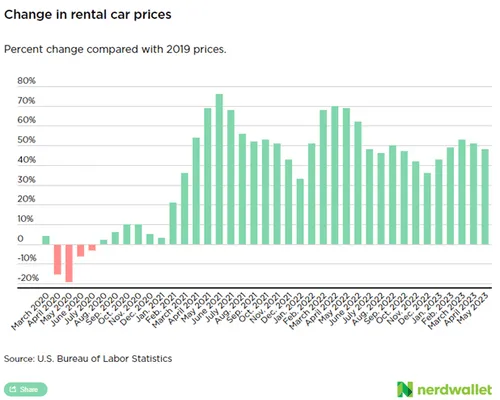
Relocation Impact and Options
While the auto rental market may seem a small piece of a complex permanent move or international assignment, consider the times relocating employees / families may need to rent a car:
- For orientation /home finding trips to the destination to explore the new community
- When vehicles are needed at the departure location while relocating families’ cars are also being shipped to the destination
- When individuals inbound from another country may not be able to purchase an auto upon arrival in the destination
To contain costs, NEI Global Relocation Account Executives proactively guide relocating families in coordinating all schedules to minimize additional costs associated with such waiting periods.
Further, to make the best of the personal or professional travel situation, one might consider the following suggestions by NerdWallet to find available vehicles at the lowest prices:
Consider ways to avoid driving altogether. Public transportation, especially in large cities, can significantly reduce the cost of a trip.
- Check out alternatives to traditional rental car companies. Turo, Getaround and Audi on demand all offer different pricing and rental models, which could save money.
- Make smart shopping choices. Not all rental car companies have the same prices, nor do all locations. For example, renting a car at the airport is 26 percent more expensive than a downtown location, according to a NerdWallet analysis of 360 rental car reservations to better understand the cheapest ways to rent.
Among the rental car companies in the analysis, Enterprise was often the cheapest, while National was often the most expensive. It also found that last minute rentals are typically cheaper than those booked months in advance, and one may almost always save by booking at an off-site rental car location versus at the airport.
NerdWallet also recommends using a search engine that compares several rental car companies to obtain the best rate. However, make sure the final price includes all taxes, fees, and insurance costs needed.
Last, but not least, don’t over-pay for coverage that might already be provided through your credit card benefits.
Freedom to Get Around
It is believed rental car prices might come down later this year or early next. However, we’ve heard this before and statistics regularly show people are traveling for pleasure and business today more than ever and making up for lost travel opportunities due to the pandemic.
Renting a car can be a rewarding experience – allowing for independence and freedom – but stress and relocation costs can be minimized with proactive awareness. NEI consistently works with our clients to discuss the most cost-effective options available.
If you would like to discuss this or other relocation / travel policy trends or cost-saving solutions, please reach out to your NEI representative.
The first half of 2023 is behind us...
...But there’s much economic and real estate market uncertainty going into the second half for renters and homeowners. How will this affect global mobility and relocation services?
Real Estate Market Tug of War
Lawrence Yun, Chief Economist, National Association of Realtors (NAR) recently captured the changing real estate market conditions succinctly: “The market is clearly turning.”
Yet demand is not diminishing with the scarcity of single-family homes and there’s only a three-month supply of existing inventory. Add on to that, one-in-seven homeowners refuse to sell due to current mortgage rates. This puts continued pressure on rising home prices.
“Home price trends are caught in a tug of war between stretched buyer budgets and limited inventory forcing competition despite reduced affordability,” said Danielle Hale, Chief Economist for Realtor.com.
What can be done to help relocating employees with this issue in 2023 and 2024?
Good News / Bad News: First Time Homebuyers
While lower home values could hurt sellers, any listing price drops may entice buyers to submit offers – especially Millennials who rent. This is especially true for the record number of American renters who are spending at least one-third of their income on rents, according to Harvard’s Joint Center for Housing Studies.
However, paying a lower home purchase price and then having to finance it with a high interest rate can seem like “good news/bad news” to first time home buyers. In Q2 2023, the share of all prospective buyers who are in the market for the first time dropped to 61 percent, down from 71 percent in the first quarter per the National Association of Home Builders.
New construction has become an alternative solution for some frustrated buyers. Sales in the $200,000-$300,000 range for new builds surged in May 2023 to 12,000 new home builds sold, compared to May 2022 when only 5,000 sold. With that in mind, 51 percent of all housing market construction in Q1 2022 was for high-cost / luxury rental units and this shift towards higher-cost rental units has been observed through Q1 of 2023, per Moody’s.
Companies can help renting relocating employees who wish to become homeowners. NEI sees more companies now offering reimbursement of destination home closing costs and direct-billed mortgage partner assistance to relocating renters.
Another method companies can use to help recruit critical talent to needed locations is to offer homebuyers funds towards new home down payments or other incentives in the form of forgivable loans that don’t have to be paid back unless the employee leaves the company within a certain period, perhaps two or three years.
High-Rate Environment Drives Corporate Relocation Assistance
There are limited incentives for homeowners to give up their low mortgage interest rate when securing a new 30-year fixed mortgage since the average rate now sits in the seven percent range - over double the average rate during the pandemic.
Fed Chairman Jerome Powell was watching the unfolding situation carefully: “Housing is very interest-sensitive…it’s one of the first places that’s either helped by low rates or held back by higher rates.”
With possibly one or two more Federal Reserve rate hikes expected this year, consider the following options to help employees/candidates consider a company-sponsored move in such a high-rate environment:
- 3-2-1 Interest-Based Mortgage Subsidy
An appealing option for companies to consider is a subsidy program that supports mortgage payments over a set period to help the employee ease into the higher mortgage payment.
Many companies use a three-year period with the subsidized rate decreasing each year until the company would no longer subsidize interest. For budgeting, some prefer to define a maximum subsidy dollar amount spent per year for the benefit.
- Mortgage Interest Differential Allowance (MIDA)
MIDA was developed as a solution to assist employees purchasing a home at a significantly higher interest rate. Eligibility is based on if a specific interest rate threshold is passed (e.g., 7.5 or 8 percent with at least 2 percent differential on the employee’s existing mortgage). The company would temporarily pay the difference in interest between the employee’s former mortgage rate and their new one, for a set amount of time. The MIDA is sent to the lender and reflected on the employee’s payment.
Some mobility policies require employees to invest their full equity from the sale of the old home into the new home’s purchase to be eligible and maximums are sometimes placed on the total differential.
- Prepaid Interest
Companies can pay for loan discount points to assist relocating employees facing higher rates on a home purchase. Discount points are paid up front in exchange for a lower interest rate over the life of the loan.
Some mobility policies have a sliding scale for points coverage tied to the current market rate. If using a sliding scale, it may make sense to lower thresholds. Companies may offer to pay for one point when rates reach seven percent, two points at eight percent, and so forth. Thresholds help keep pace with changing rates and make moving more agreeable. Because this benefit impacts the life of the loan, this may not be the best option for an employee who could be relocated again within a few years.
Few Economists Expect Housing Crash
Predictions about a housing market crash create headlines, but few economists expect a nationwide decline like 2007-2009. Consider some big differences today:
- There are simply not enough homes to meet current demand and the country ultimately needs 4.3 million more homes, according to a Zillow analysis.
- Most homeowners with a mortgage today have great credit, significant home equity and a low rate. Housing prices in October 2022 were 38.1 percent higher than they were at the start of the pandemic in March 2020, per Fortune.
- About 90 percent of U.S. mortgaged homeowners have an interest rate below 6 percent, a Redfin report showed. 62 percent have a rate below 4 percent and nearly one-quarter have mortgage rates below 3 percent.
- Home value increases or decreases are more impacted by location today as compared to nationwide 15 years ago. Western U.S. home values have been hit particularly hard.
- Finally, we have strong consumer demand today and unsold inventory sits at a 3.1-month supply. “There are simply not enough homes for sale,” said Lawrence Yun of NAR. Realtor.com reported home sellers were less active in June 2023 with 25.7 percent fewer homes newly listed for sale compared to 2022.
For comparison, there was an 11-month supply of inventory in June 2008, interest rates were 6.32 percent, and 33.8 percent of homeowners were in a negative equity position. Since then prime mortgage requirements have become significantly tighter.
Unpredictable Markets, Proactive Relocation Services
The U.S. may likely end 2023 with higher short-term interest rates, but Moody’s Analytics Chief Economist Mark Zandi anticipates housing affordability will improve over the next few years, as reported in Fortune magazine.
Zandi feels rates will drift towards 5.5 percent in 2025 and national home prices may fall around eight percent, but "In our thinking this [price] weakness plays out over the next three years, there's no cliff event here, it's more of a slow grind lower," Zandi told Fortune.
NEI proactively counsels relocating employees about the emotional ups and downs when buying/selling a home and during the necessary negotiations, and we help clients brainstorm solutions. NEI monitors market and economic conditions to proactively discuss various options with clients, so client recruitment and retention goals are achieved.
For more information on the above or other needs or to discuss in more detail, please reach out to your NEI representative.
This material has been prepared for informational purposes only, and is not intended to provide, and should not be relied on for, tax, legal or accounting advice. You should consult your own tax, legal and accounting advisors before engaging in any transaction.
Changes Coming to Banking Regulations in the UK
An important change was announced regarding the list of countries where supporting assignees in opening bank accounts is allowed while still in the home country and prior to arrival in the UK.
Previously, global bank HSBC had been able to open accounts for residents of 27 EU countries while they were still in their home country. Due to changes in cross-border regulations and recent developments regarding Brexit, the number of eligible EU countries has been reduced to 12 with immediate effect.
Please see the revised list of 12 EU countries below, provided by NEI’s London-based service partner Icon Relocation, where HSBC can support assignees with a UK account before arrival in the UK. There is no change with supported international countries outside the EU.
Note: this chart relates to the country of residence, not the nationality.
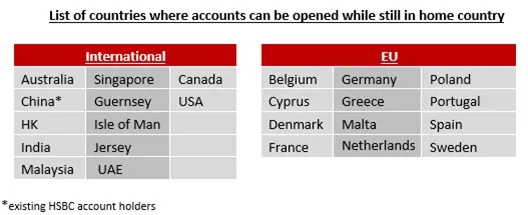
According to Icon Relocation, assignees living in the approved countries can provide proof of their overseas address. HSBC and Barclays Bank will continue to support other assignees once they have arrived in the UK without the need for proof of a permanent UK address.
Reminder of Documents Required
- Proof of identity document, e.g., passport.
- Address verification document for one’s residential address in the UK or overseas. HSBC can accept a letter from one’s employer that must be from a member of the HR team, issued on UK company letterhead, and include employment dates. The letter must also include a UK address if known or an overseas address if the UK address is unknown or not yet confirmed.
- Salary verification may be required.
- Verbal disclosure of Tax Identification Number.
NEI and our global service partners will continue to provide clients with updated information on this topic and others as they arise and to manage relocating employee expectations accordingly.
If you would like to discuss this visa and immigration situation further, please reach out to your NEI representative or Mollie Ivancic, NEI’s VP, International Services.
This material has been prepared for informational purposes only, and is not intended to provide, and should not be relied on for, tax, legal or accounting advice. You should consult your own tax, legal and accounting advisors before engaging in any transaction.
NEI Service Partner Spotlight - Bennett International
This month’s NEI Service Partner Spotlight features Bennett International’s President, Timothy Dwyer, discussing the challenges associated with coordinating school and home selections for all relocating assignees and their families.
What to Focus On?
It’s the mobility world’s equivalent of the “chicken or the egg” conundrum: when preparing to move to a new location, should the family focus first on schooling or on housing? In an ideal world, the child would be placed in a school with an appropriate curriculum that is a good match for their learning style and needs, while the family’s housing would be in a vibrant, safe neighborhood not too far from both the school and the parents’ work locations. That ideal world can be tough to achieve.
Making the right choices for both housing and schooling are crucial to the success of an international assignment, but getting there often requires expertise in both areas and simultaneous, closely coordinated searches. And when the intention is for the children to attend public (free) schools (as opposed to fee-based Private or International Schools), the challenge becomes even more complex.
No Guarantees
Perhaps the most common misperception is that residing in a particular neighborhood— within the “catchment area” of a desired school—will result in the child attending that particular school. A "catchment" is a defined area of a community within which a school will normally accept students. Depending on the country and specific location, living inside the designated catchment area may improve the child’s chances of attending a particular school, but it is rarely a guarantee. There are several factors that might come into play:
- Limited Space. The school might not have enough room. Neighborhoods with “good” schools tend to attract residents, resulting in schools being filled to capacity. Last year, in the greater London area, almost 20 percent of secondary school students did not receive a place at their preferred school because of limited space.
- Special Needs. The child might have a special education need which is not adequately supported by the nearest school, and they may therefore be directed to a school better equipped to address their specific need. This could also happen if the child is not sufficiently conversant in the host-country language; many cities have public schools dedicated to supporting students with significant language needs.
- Barrier to Entry. The nearest school might be a charter, magnet, specialized, or other type of selective school which has a barrier to entry. This might consist of academic prerequisites, a required examination, academic achievement and/or nomination from the child’s current school, some schools even employ a lottery system for entry.
Often the first steps of the admission process and related exams for these schools begin long before the start of the school year. Newly arrived families are at a distinct disadvantage when competing with those who have already been navigating the process for months or sometimes even years.
At the same time, finding suitable housing in the right location that is within the employee’s budget can also be difficult in many major cities. Often, desirable properties are on the market only briefly before they are snatched up. Yet a relocating family can be hesitant to commit to a property until schooling is settled. The challenge in that situation is that many public schools can require proof of long-term residence (such as a signed lease) before they will allow a child to enroll.
Close Collaboration is Key
When housing and schooling both pose challenges for relocating families—a situation we see in many high-volume destinations—the most effective answer is for the home-finding and education advisement experts to work closely together throughout the relocation process. They must be able to form a team, balancing the priorities and requirements in each area while keeping the family’s best interests front and center. Few things can be more frustrating for a family going through the stress of relocating than receiving contradictory guidance from different members of the team assembled to support them.
When Bennett is part of a relocation support team, we embrace good coordination with our settling-in and real estate partners. We have seen how thoughtful, friendly, and creative collaboration between all players on a relocation team is the key to a seamless and positive experience for the relocating family. Indeed, it’s the well-woven safety net of expert service providers that can transform the assignee and family experience from one of uncertainty and stress to one of clarity and excitement. Our goal is for the assignee to not only realize that an assignment can “work”, but to welcome it as a rich and thrilling next chapter—for them and for their children.
If you have questions about the support available to relocating families on international assignments, please contact Mollie Ivancic, VP International Services at NEI Global Relocation.
Surging Global Rent Prices
Rent prices worldwide have been surging at an alarming rate, increasing by 23.5 percent since 2019; with a projected compound annual growth rate (CAGR) of seven and two tenths percent for rental properties until 2027. This global phenomenon is driven by multiple factors, such as:
- Growing preference for renting among millennials
- Limited housing supply
- Rising homeownership costs
- Return of transferees or natives to their home countries
These soaring rent prices are compelling companies to reassess their relocation strategies. Let's delve into the rent increases across different regions and explore the implications for company relocations.
United States and Canada
Renting instead of buying has been more popular for individuals and transferees. According to Dwellworks, the United States has been building rental supply at a significant pace, with nearly 400,000 multi-family units being built since April. However, Single-family units are still behind on the amount of supply needed to cover the demand for transferees who might prefer a home.
Rental markets are still seeing a spike in demand for rental units however, with most of these being cities based in the Midwest due to their lower cost of living, the highest rise in rent YOY include:
- Indianapolis, seven and four tenths’ percent YOY
- Kansas City, seven percent YOY
- Chicago, Columbus, Cincinnati, and St. Louis, six percent YOY
According to Realtor.com, the average monthly rent for a one-bedroom apartment in the U.S. from May 2023 is $1,628 USD and $1,903 USD for a two-bedroom apartment. Like the U.S., Canada is grappling with a shortage of housing supply and escalating demand. The average rent for a one-bedroom apartment in Canada stands at $1,811 CAD ($1,356 USD), while a two-bedroom apartment commands $2,239 CAD ($1,677 USD). It is unlikely that the rent will lower in Canada anytime soon, best-case scenario is that rents will remain the same.
Little to no new construction, particularly in cities like Toronto and Vancouver, coupled with high immigration rates have further exacerbated the rental price surge and international transferees are usually placed near the bottom of the priority list.
EMEA
Europe overall has seen a spike in rent increases due to inflation and shifting relocation patterns, keeping transferees in major urban cores.
In the United Kingdom, the Renter's Reform Bill is awaiting a second reading in Parliament. While the bill aims to grant transferees more rights, such as protection against arbitrary evictions and accommodations for children and pets, it has inadvertently triggered a wave of evictions by private property owners and a significant spike in rental prices. As of April 2023, rent in the Greater London Area reached £2,516 GBP ($3,170 USD) per month for a one-bedroom flat, and a two-bedroom flat going for £3,448 GBP ($4,344 USD). This represents an increase of nearly £200 compared to the previous year.
In Dubai, rental prices have soared due to intense competition to acquire a "golden visa," a slowdown in construction activities, and stricter financing policies. Between January and April 2023, rents surged by almost 26 percent, with the average monthly rent for an apartment reaching 8,556 AED ($2,330 USD).
APAC
Singapore has experienced a staggering surge in rent, with an average monthly cost of $5,075 USD, surpassing Hong Kong as the most expensive rental market. Although experts anticipate a potential cooling down later in the year, Singapore's measures to stabilize the market and a decline in demand resulting from tech sector layoffs have influenced rental prices. Moreover, native Singaporeans are increasingly choosing to rent as singles, adding to the growing demand.
Australia has witnessed an 11.2 percent increase in median house rent during the first quarter of 2023. Factors contributing to this surge include the reopening of borders, high immigration rates, proprietors capitalizing on the heightened demand, rising construction costs, and favorable tax policies for property owners.
Conclusion
As the world navigates a new way of life, these rent fluctuations may persist, posing challenges for relocating employees and temporary assignees. NEI recognizes the complexities involved in global mobility and strives to secure suitable housing for transferees and assignees well in advance. While being proactive and starting an early search is important, understand that housing costs will still be high. Allocating an appropriate budget remains the most crucial step.
NEI works globally with local destination service providers who are on location and in country to provide the most timely and relevant picture of local market conditions. They can provide the best options available at any given time. If you have concerns related to the global escalation of rental rates, please reach out to your NEI representative for more information.
This material has been prepared for informational purposes only and is not intended to provide, and should not be relied on for tax, legal or accounting advice. Please consult your own tax, legal and accounting advisors before engaging in any transaction.

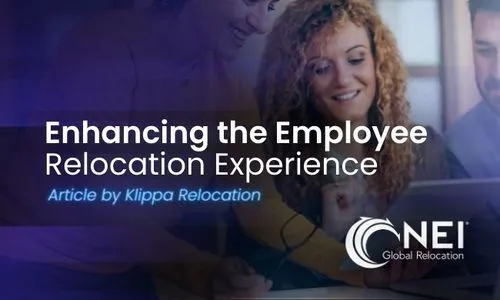











.webp)




.webp)





